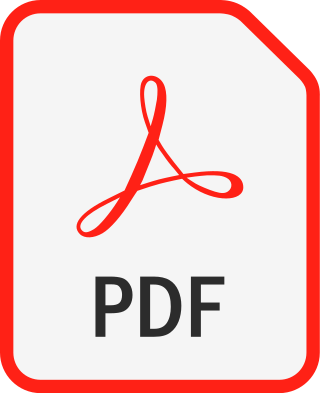
Portable Document Format (PDF), standardized as ISO 32000, is a file format developed by Adobe in 1992 to present documents, including text formatting and images, in a manner independent of application software, hardware, and operating systems. Based on the PostScript language, each PDF file encapsulates a complete description of a fixed-layout flat document, including the text, fonts, vector graphics, raster images and other information needed to display it. PDF has its roots in "The Camelot Project" initiated by Adobe co-founder John Warnock in 1991.

A digital signature is a mathematical scheme for verifying the authenticity of digital messages or documents. A valid digital signature, where the prerequisites are satisfied, gives a recipient very high confidence that the message was created by a known sender (authenticity), and that the message was not altered in transit (integrity).
An electronic signature, or e-signature, is data that is logically associated with other data and which is used by the signatory to sign the associated data. This type of signature has the same legal standing as a handwritten signature as long as it adheres to the requirements of the specific regulation under which it was created.
Electronic authentication is the process of establishing confidence in user identities electronically presented to an information system. Digital authentication, or e-authentication, may be used synonymously when referring to the authentication process that confirms or certifies a person's identity and works. When used in conjunction with an electronic signature, it can provide evidence of whether data received has been tampered with after being signed by its original sender. Electronic authentication can reduce the risk of fraud and identity theft by verifying that a person is who they say they are when performing transactions online.
XAdES is a set of extensions to XML-DSig recommendation making it suitable for advanced electronic signatures. W3C and ETSI maintain and update XAdES together.
Worldwide, legislation concerning the effect and validity of electronic signatures, including, but not limited to, cryptographic digital signatures, includes:
Digital Signature Services (DSS) is an OASIS standard.
Trusted timestamping is the process of securely keeping track of the creation and modification time of a document. Security here means that no one—not even the owner of the document—should be able to change it once it has been recorded provided that the timestamper's integrity is never compromised.
CAdES is a set of extensions to Cryptographic Message Syntax (CMS) signed data making it suitable for advanced electronic signatures.
ARX is a digital security company headquartered in San Francisco, CA, with offices in the UK, the Netherlands, Australia and Israel. It is the creator of CoSign by ARX, a digital signature technology, along with related digital signature security technology products. ARX was acquired by DocuSign in May 2015. The acquisition builds on a three-year business partnership between DocuSign and ARX, bringing together ARX's CoSign digital signature technology with DocuSign's Digital Transaction Management (DTM) platform and broadens The DocuSign Global Trust Network.

eIDAS is an EU regulation on electronic identification and trust services for electronic transactions in the European Single Market. It was established in EU Regulation 910/2014 of 23 July 2014 on electronic identification and repeals 1999/93/EC from 13 December 1999.
An advanced electronic signature (AdES) is an electronic signature that has met the requirements set forth under EU Regulation No 910/2014 (eIDAS-regulation) on electronic identification and trust services for electronic transactions in the European Single Market.
ZertES is a Swiss Federal law that regulates the conditions under which trust service providers may use certification services with electronic signatures. Additionally, this law provides a framework that outlines the provider’s obligations and rights as they apply to providing their certification services.
A qualified electronic signature is an electronic signature that is compliant with EU Regulation No 910/2014 for electronic transactions within the internal European market. It enables to verify the authorship of a declaration in electronic data exchange over long periods of time. Qualified electronic signatures can be considered as a digital equivalent to handwritten signatures.
A trust service provider (TSP) is a person or legal entity providing and preserving digital certificates to create and validate electronic signatures and to authenticate their signatories as well as websites in general. Trust service providers are qualified certificate authorities required in the European Union and in Switzerland in the context of regulated electronic signing procedures.
In the context of Regulation (EU) No 910/2014 (eIDAS), a qualified digital certificate is a public key certificate issued by a trust service provider which has government-issued qualifications. The certificate is designed to ensure the authenticity and data integrity of an electronic signature and its accompanying message and/or attached data.
A secure signature creation device (SSCD) is a specific type of computer hardware or software that is used in creating an electronic signature. To be put into service as a secure signature creation device, the device must meet the rigorous requirements laid out under Annex II of Regulation (EU) No 910/2014 (eIDAS), where it is referred to as a qualified (electronic) signature creation device (QSCD). Using secure signature creation devices helps in facilitating online business processes that save time and money with transactions made within the public and private sectors.
Associated Signature Containers (ASiC) specifies the use of container structures to bind together one or more signed objects with either advanced electronic signatures or timestamp tokens into one single digital container.

A qualified website authentication certificate is a qualified digital certificate under the trust services defined in the European Union eIDAS Regulation.
An electronic seal is a piece of data attached to an electronic document or other data, which ensures data origin and integrity. The term is used in the EU Regulation No 910/2014 for electronic transactions within the internal European market.

